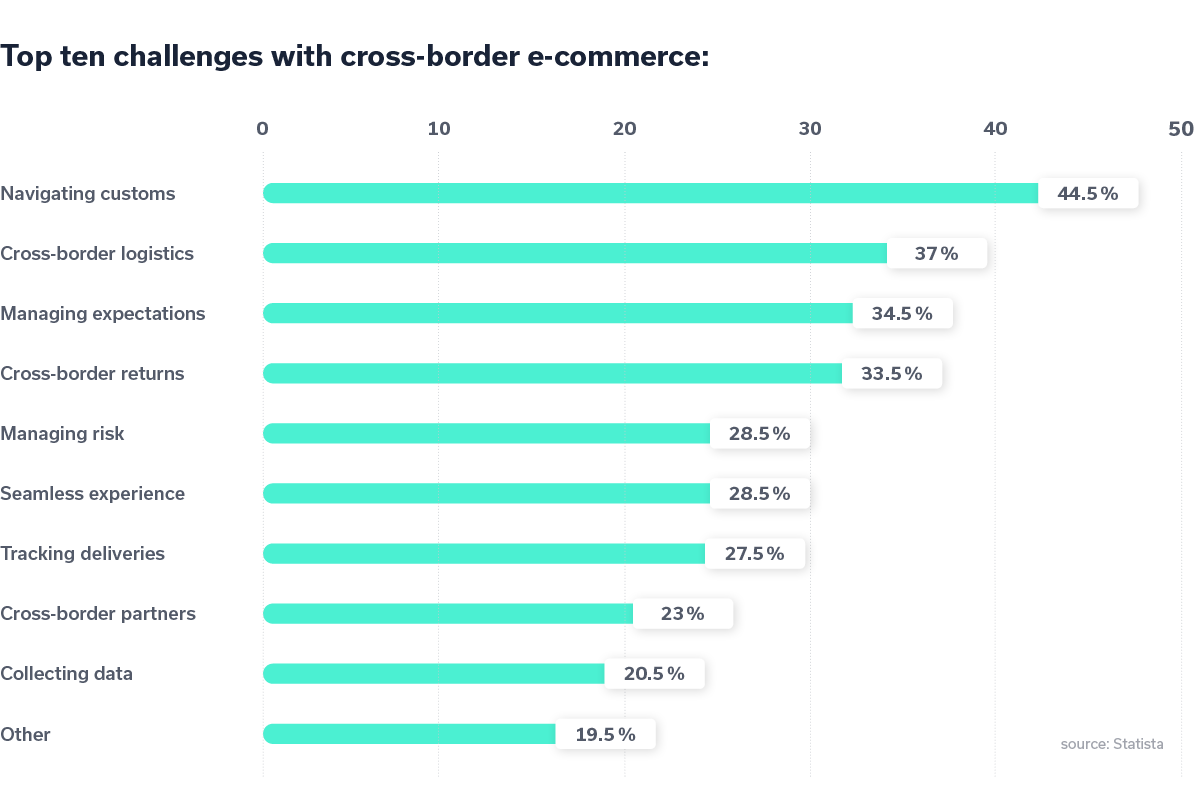Challenges of cross-border e-commerce & how to overcome them with 3PL
So, you have an e-commerce store, and you want to sell to foreign customers. It is simple, right? You just need to implement the necessary payment providers so that your customers can pay from abroad, and you’re good to go. Not so fast.
Before you can start selling and shipping to another country, you should consider and understand a lot of things. These include things like customs, duties, and you’ll need to have the proper documents in place.
In simple terms, if you want to sell to customers outside of your customs area, you’ll need to take care of all these practical details before you can start selling. And here’s the problem. It can get pretty complex.
In fact, according to research, the biggest challenges of cross-border e-commerce for businesses are:
- Navigating customs
- Cross-border logistics
- Managing expectations
Ultimately, this means if you want to start selling abroad, you’ll need to develop a cross-border e-commerce plan that takes all these factors into account.
But where do you start? In this post, we’ll look at developing a cross-border e-commerce plan and give you a more straightforward solution that takes the hassle out of cross-border selling.

How to craft a cross-border e-commerce plan?
To develop this plan, there are several things that you should consider.
1. The e-commerce shop set-up
The first thing you should look at is to make sure that your shop is set up for international sales. For one, you’ll have to set up the currency because it’s frustrating for customers to have to calculate the exchange rate on their own. This results in a less-than-optimal customer experience and, ultimately, lost customers.
You also have to implement the correct payment methods. Here, the key is to have more than one payment method because customers like to choose. Besides, when customers have multiple payment options, it leads to an easier sales process and more sales.
Apart from this, you should research payment methods that are accepted in the countries you want to sell to and then make sure that you can support those payment methods.
The next part of your shop setup is vital. You have to localize your shop to the market you want to sell to. With 80% of non-English speaking consumers refusing to shop from shops that only offer English as a language, you must translate your e-commerce shop and checkout pages into the local languages.
Keep in mind that you’ll also need to be sensitive to cultural nuances and language differences when building marketing campaigns and writing product descriptions.
2. Customs
The next thing you should look at is customs regulations and customs fees. This is simply because every product you ship is required to clear customs. During this process, documentation and declarations will also need to be filled out, both in your country and the country you’re shipping to.
In addition, custom fees also need to be paid, and this varies by product and country. As a result, you must have a process in place to check the customs fees before shipping.
Consider using professional help, like Simply VAT with customs documentation, VAT registration and other paper work.
3. Shipping
And when it comes to shipping, there are also several things you should consider. For one, you’ll need to choose the correct shipping partners and shipping methods that would not only be the most economical to your customers but also deliver the most efficient and effective service.
In addition, you should also negotiate contracts with logistics companies so that you can offer your customers the best shipping prices. Remember, shipping may often lead to a customer abandoning a cart because the shipping costs are too high.
If you use a professional 3PL partner to take care of warehousing, order fulfillment and shipping, these things are covered for you.
Also keep in mind that you also have to make sure about the shipping rules to not inadvertently ship restricted items to countries where they’re not allowed.
One of the most critical aspects here is that you communicate the shipping times on your e-commerce shop. In this way, your customers know exactly how long their product will take to be delivered to them to better manage their expectations.
4. Returns
Okay, so now you’ve sorted out payment, customs, and shipping, and you’re ready to sell. Not so fast. What happens if a customer wants to return a product? Because 90% of shoppers check the return policies on an e-commerce store before buying, you must have a return policy in place.
This is to quell the fears of customers and because a return would inevitably happen. For this reason, you have to figure out precisely how your returns will work and what the associated fees will be.
Cross-border e-commerce via a 3PL partner
Now, you have an idea of what goes into developing a cross-border e-commerce plan. But what if you don’t want to do it yourself, and you want to take the hassle out of selling internationally?
Here, another option would be to use a 3PL partner to do it for you. But wait, what’s 3PL?
Third-party logistics, or 3PL for short, can be a significant part of your effective e-commerce strategy. In simple terms, 3PL firms make it easier for you to sell internationally because you outsource some (or all) of your warehousing, logistics, picking and packing and shipping.
By using a 3PL partner you’ll usually get faster shipping for your products, and you’ll have time to focus on what you do best, that is building and running your e-commerce shop.
Some other benefits you’re going by using a 3PL partner are:
- You’ll gain cost efficiency through pre-negotiated volume-based logistics contracts
- You avoid significant investments because you don’t have to have your own warehouse.
- You’ll be able to offer your customers more delivery options.
- You’ll always have secure and reliable operations.
- You’ll save time to scale and grow your business.

Choosing the right 3PL partner
Now, this sounds better, doesn’t it? But how do you go about choosing the right 3PL partner?
It’s evident that you need a partner that can take as much of the hassle out of cross-border e-commerce as possible. Remember that even if you use a 3PL partner, you’ll still need to do some paperwork related to your cross-border e-commerce sales yourself.
For example, you’ll need to sort out things like VAT, customs, and payments.
Another thing you should look at is whether the partner allows you to “nearshore” your inventory. In OGOship’s 3PL terminology, this means “optimized supply chain by multiwarehousing.” By doing this, the 3PL partner stores some of your inventory closer to the place where your customers are and where you will be shipping to.
As a result, you’ll get your orders to your customers quickly, cheaper, and you’ll reduce your CO2 emissions.
Some e-commerce businesses may even choose to use multiple 3PL partners when they sell to different markets. Now, this could be the right solution if you’re selling to a lot of markets and you have really high shipping volumes. Keep in mind, though, that you may have to manage multiple order management systems, multiple processes, and multiple e-commerce platform integrations – unless you find a partner that can support all your target markets.
The bottom line
If you want to take the hassle out of cross-border e-commerce, your best bet is to use a 3PL partner. It simplifies the entire shipping and logistics aspect of your business so that you can spend more time focusing on running it.
OGOship supports cross-border e-commerce and allows you to store your products in various locations. You’ll have only one central place where you manage everything: OGOship’s Order Management System myOGO.
Also, we help you with the VAT details through our partnership with Simply VAT, a company dedicated to assisting international businesses to succeed with their VAT compliance issues.
If you want to know more about 3PL or the services we offer, talk with our e-commerce experts and see how we could help with your cross-border e-commerce challenges.{{cta(‘7dbedc37-bed3-4fc2-8bb4-686423f736ca’)}}